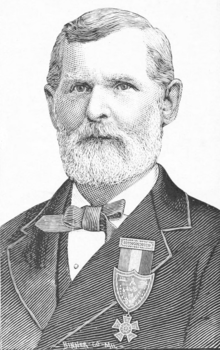Lafayette Houghton Bunnell (March 13, 1824 – July 21, 1903) was an American physician, author, and explorer. He is most well known for his involvement with the Mariposa Battalion, the first non-Indians to enter Yosemite Valley, and his book Discovery of the Yosemite and the Indian War of 1851. Bunnell led the battalion members in a vote to name the valley, and for this reason he is often credited as the person who named Yosemite. He was also a soldier and surgeon in the United States war with Mexico and the Civil War.
Lafayette Bunnell | |
|---|---|
 | |
| Born | Lafayette Houghton Bunnell March 13, 1824 |
| Died | July 21, 1903 (aged 79) |
| Nationality | American |
| Occupation(s) | Army surgeon, explorer, historian |
| Known for | Naming Yosemite |
| Signature | |
Biography
editBunnell was born in Rochester, New York on March 13, 1824.[1] His father Bradley Bunnell and his uncle Douglass Houghton (both physicians) were a major influence on young Lafayette, especially instilling in him a desire to seek adventure in "the West." In 1832 Bunnell's father Bradley decided to move to Detroit, although the family stayed over in Buffalo prior to the final move; because of a cholera epidemic, Bradley Bunnell was called on to treat the sick. When they did finally settle in Detroit, young Bunnell was friends with the Ojibwe, Potowatami and French-Canadian youth. He attended a catholic school, not because he was catholic but because it was the best school in the town.[2]
In 1845 Bunnell's father returned to Detroit. After settling various business affairs, Bunnell followed him and recommenced studying medicine under Dr. Scoville. When the War with Mexico broke out, Bunnell enlisted and worked as an orderly. For a while he was in charge of the hospital in Cordova, and had medical command of a regiment when they returned to Michigan at the end of the war. After being mustered out, rumors of the gold strike in California were confirmed by President Polk, and Bunnell decided to seek his fortune in California. He traveled overland by way of Texas and Mexico.[3]
During the winter of 1849–50, while ascending the old Bear Valley trail from Ridley's ferry, on the Merced river, my attention was attracted to the stupendous rocky peaks of the Sierra Nevadas. In the distance an immense cliff loomed, apparently to the summit of the mountains. Although familiar with nature in her wildest moods, I looked upon this awe-inspiring column with wonder and admiration. ... Whenever an opportunity afforded, I made inquiries concerning the scenery of that locality. But few of the miners had noticed any of its special peculiarities.
— Lafayette Houghton Bunnell, Discovery of the Yosemite and the Indian War of 1851 Which Led to That Event
In 1851, Bunnell was a member of the Mariposa Battalion that became the non-indigenous discoverers of the Yosemite Valley. Discovery was not the main purpose of the trip: the Battalion rode out in search of Native American tribal leaders involved in recent raids on American settlements. Bunnell explored the Valley and named many of its features. Discovery of the Yosemite, and the Indian war of 1851 (1880) contains his account of his exploration and the actions of the Battalion. The majority of what is known about Chief Tenaya and the Ahwahnechee was from Bunnell's written accounts. Bunnell was the first person who encountered Chief Tenaya who subsequently wrote a book.[4]
Bunnell later served as a surgeon in the American Civil War. After the war he moved to Homer, Minnesota and married Sarah Smith. Although he practiced medicine a little, for the most part he lived off his army pensions and wrote histories of the upper Mississippi. He died in Homer on July 21, 1903.[5]
Legacy
editBunnell Point at the east end of Little Yosemite Valley is named in his honour.[6]
References
edit- ^ Herringshaw 1909, p. 491.
- ^ Kelly 1921, pp. 180–181.
- ^ HH Hill 1883, p. 93.
- ^ Cossley-Batt 1928.
- ^ Kelly 1921, pp. 191–192.
- ^ Farquhar 1926.
Attributions
edit- Herringshaw, Thomas William (1909). Herringshaw's National Library of American Biography. Chicago: American Publishers' Association. Retrieved December 2, 2013.
- Kelly, Howard A. (1921). "Lafayette Houghton Bunnell, M.D., Discoverer of the Yosemite". Annals of Medical History. III (2). New York: P. B. Hoeber: 179–193. Retrieved December 3, 2013.
- Cossley-Batt, Jill (1928). The Last of the California Rangers (First ed.). New York: Funk & Wagnalls Company. OCLC 1600551.
- Farquhar, Francis P. (1926). "B - Bunnel Point". Place Names of the High Sierra. San Francisco: Sierra Club. OCLC 2871447. Retrieved December 3, 2013.
- History of Winona County. Chicago: H H Hill and Company. 1883. Retrieved December 4, 2013.
Bibliography
edit- Bunnell, Lafayette Houghton (2003) [1880]. Discovery of the Yosemite and the Indian War of 1851 Which Led to That Event. Washington, D.C.: Library of Congress, National Digital Library Program. OCLC 51675913. Retrieved 2009-01-05.
- Bunnell, Lafayette Houghton. Winona (We-No-Nah) and Its Environs on the Mississippi in Ancient and Modern Days. Winona, Minn: Jones & Kroeger, printers and publishers, 1897.
- Bunnell, Lafayette Houghton. The Date of the Discovery of the Yosemite. New York: Century Co, 1890.
External links
edit- Discovery of the Yosemite (1892) by Lafayette H. Bunnell. Yosemite Research Library link which contains auxiliary information on Bunnell and his account.